Business Ethics and Corporate Governance Case Study Report 3006IBA
VerifiedAdded on 2022/12/19
|8
|2406
|1
Case Study
AI Summary
This case study report examines business ethics and corporate governance through the lens of the Enron scandal and the ethical considerations surrounding Smith & Wesson. The analysis explores the ethical dilemmas faced by stakeholders, including Sherron Watkins's whistleblowing in the Enron case and the social responsibility issues of gun manufacturing. The report delves into key concepts such as utilitarianism, moral responsibility, and the impact of leadership decisions on corporate behavior. It compares and contrasts the two case studies, highlighting the similarities and differences in ethical challenges and decision-making processes. The report also addresses the importance of ethical frameworks, corporate governance mechanisms, and the evolving social contract between businesses and society. It emphasizes the need for responsible leadership, transparent financial practices, and a commitment to ethical standards to foster long-term sustainability and stakeholder trust.
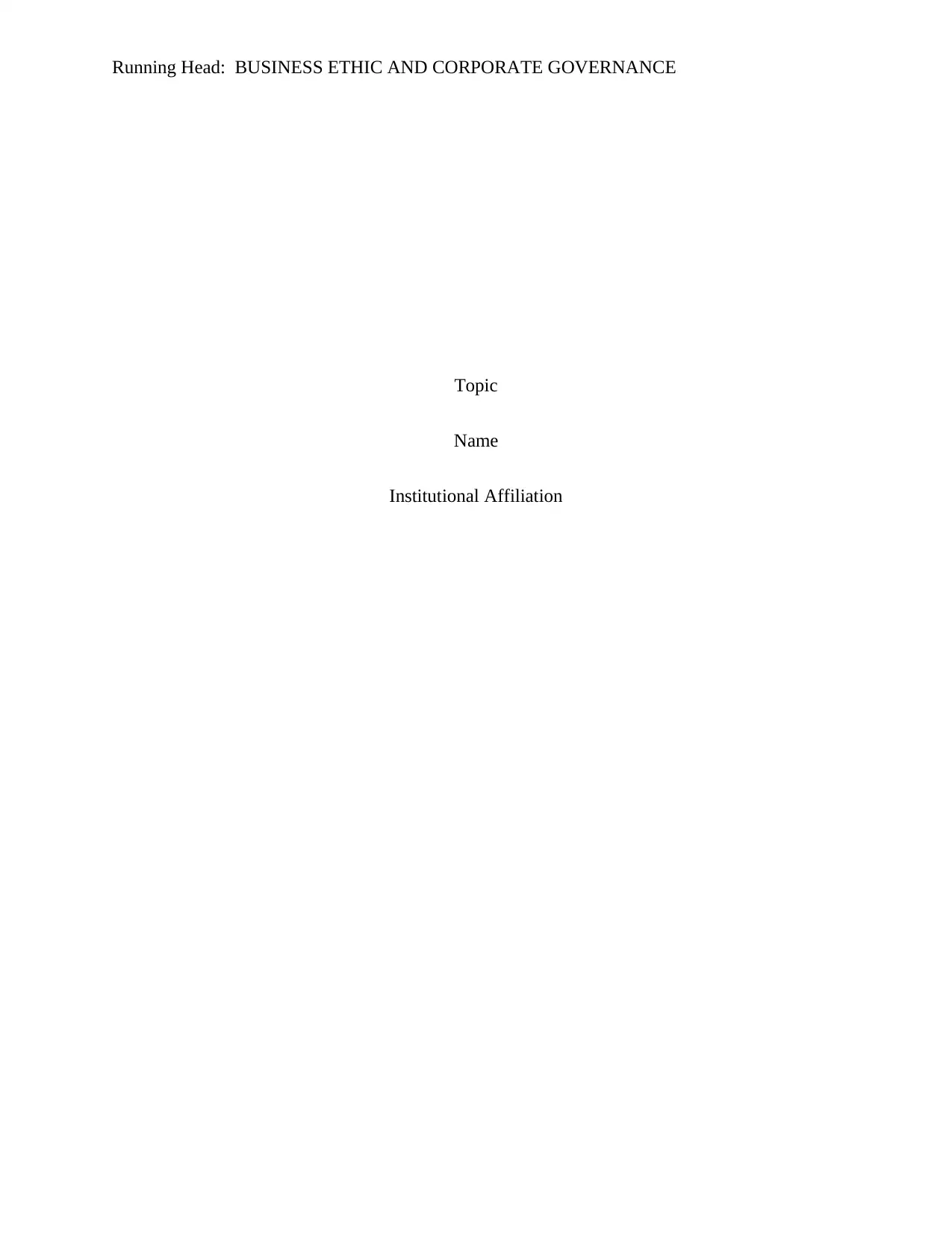
Running Head: BUSINESS ETHIC AND CORPORATE GOVERNANCE
Topic
Name
Institutional Affiliation
Topic
Name
Institutional Affiliation
Paraphrase This Document
Need a fresh take? Get an instant paraphrase of this document with our AI Paraphraser
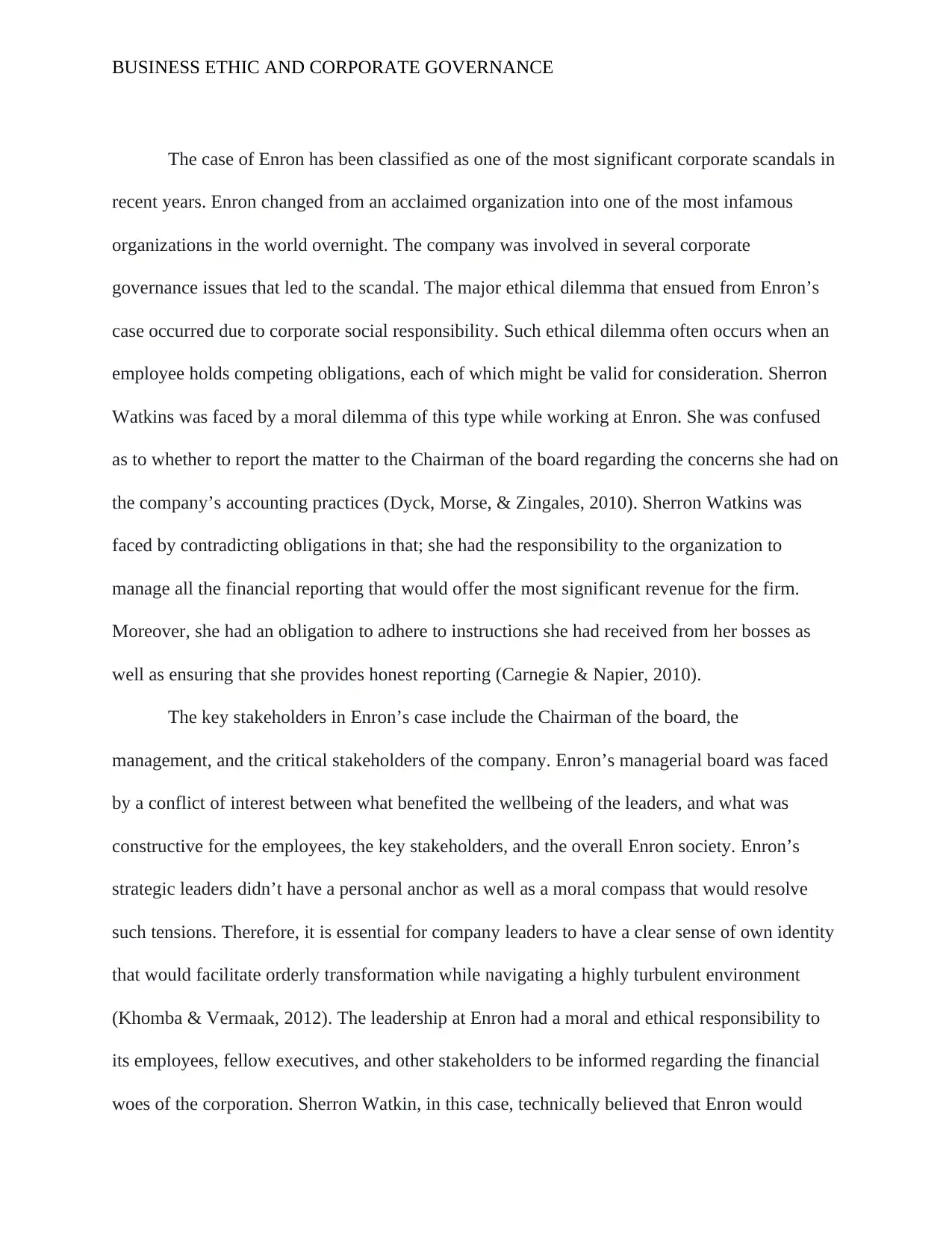
BUSINESS ETHIC AND CORPORATE GOVERNANCE
The case of Enron has been classified as one of the most significant corporate scandals in
recent years. Enron changed from an acclaimed organization into one of the most infamous
organizations in the world overnight. The company was involved in several corporate
governance issues that led to the scandal. The major ethical dilemma that ensued from Enron’s
case occurred due to corporate social responsibility. Such ethical dilemma often occurs when an
employee holds competing obligations, each of which might be valid for consideration. Sherron
Watkins was faced by a moral dilemma of this type while working at Enron. She was confused
as to whether to report the matter to the Chairman of the board regarding the concerns she had on
the company’s accounting practices (Dyck, Morse, & Zingales, 2010). Sherron Watkins was
faced by contradicting obligations in that; she had the responsibility to the organization to
manage all the financial reporting that would offer the most significant revenue for the firm.
Moreover, she had an obligation to adhere to instructions she had received from her bosses as
well as ensuring that she provides honest reporting (Carnegie & Napier, 2010).
The key stakeholders in Enron’s case include the Chairman of the board, the
management, and the critical stakeholders of the company. Enron’s managerial board was faced
by a conflict of interest between what benefited the wellbeing of the leaders, and what was
constructive for the employees, the key stakeholders, and the overall Enron society. Enron’s
strategic leaders didn’t have a personal anchor as well as a moral compass that would resolve
such tensions. Therefore, it is essential for company leaders to have a clear sense of own identity
that would facilitate orderly transformation while navigating a highly turbulent environment
(Khomba & Vermaak, 2012). The leadership at Enron had a moral and ethical responsibility to
its employees, fellow executives, and other stakeholders to be informed regarding the financial
woes of the corporation. Sherron Watkin, in this case, technically believed that Enron would
The case of Enron has been classified as one of the most significant corporate scandals in
recent years. Enron changed from an acclaimed organization into one of the most infamous
organizations in the world overnight. The company was involved in several corporate
governance issues that led to the scandal. The major ethical dilemma that ensued from Enron’s
case occurred due to corporate social responsibility. Such ethical dilemma often occurs when an
employee holds competing obligations, each of which might be valid for consideration. Sherron
Watkins was faced by a moral dilemma of this type while working at Enron. She was confused
as to whether to report the matter to the Chairman of the board regarding the concerns she had on
the company’s accounting practices (Dyck, Morse, & Zingales, 2010). Sherron Watkins was
faced by contradicting obligations in that; she had the responsibility to the organization to
manage all the financial reporting that would offer the most significant revenue for the firm.
Moreover, she had an obligation to adhere to instructions she had received from her bosses as
well as ensuring that she provides honest reporting (Carnegie & Napier, 2010).
The key stakeholders in Enron’s case include the Chairman of the board, the
management, and the critical stakeholders of the company. Enron’s managerial board was faced
by a conflict of interest between what benefited the wellbeing of the leaders, and what was
constructive for the employees, the key stakeholders, and the overall Enron society. Enron’s
strategic leaders didn’t have a personal anchor as well as a moral compass that would resolve
such tensions. Therefore, it is essential for company leaders to have a clear sense of own identity
that would facilitate orderly transformation while navigating a highly turbulent environment
(Khomba & Vermaak, 2012). The leadership at Enron had a moral and ethical responsibility to
its employees, fellow executives, and other stakeholders to be informed regarding the financial
woes of the corporation. Sherron Watkin, in this case, technically believed that Enron would
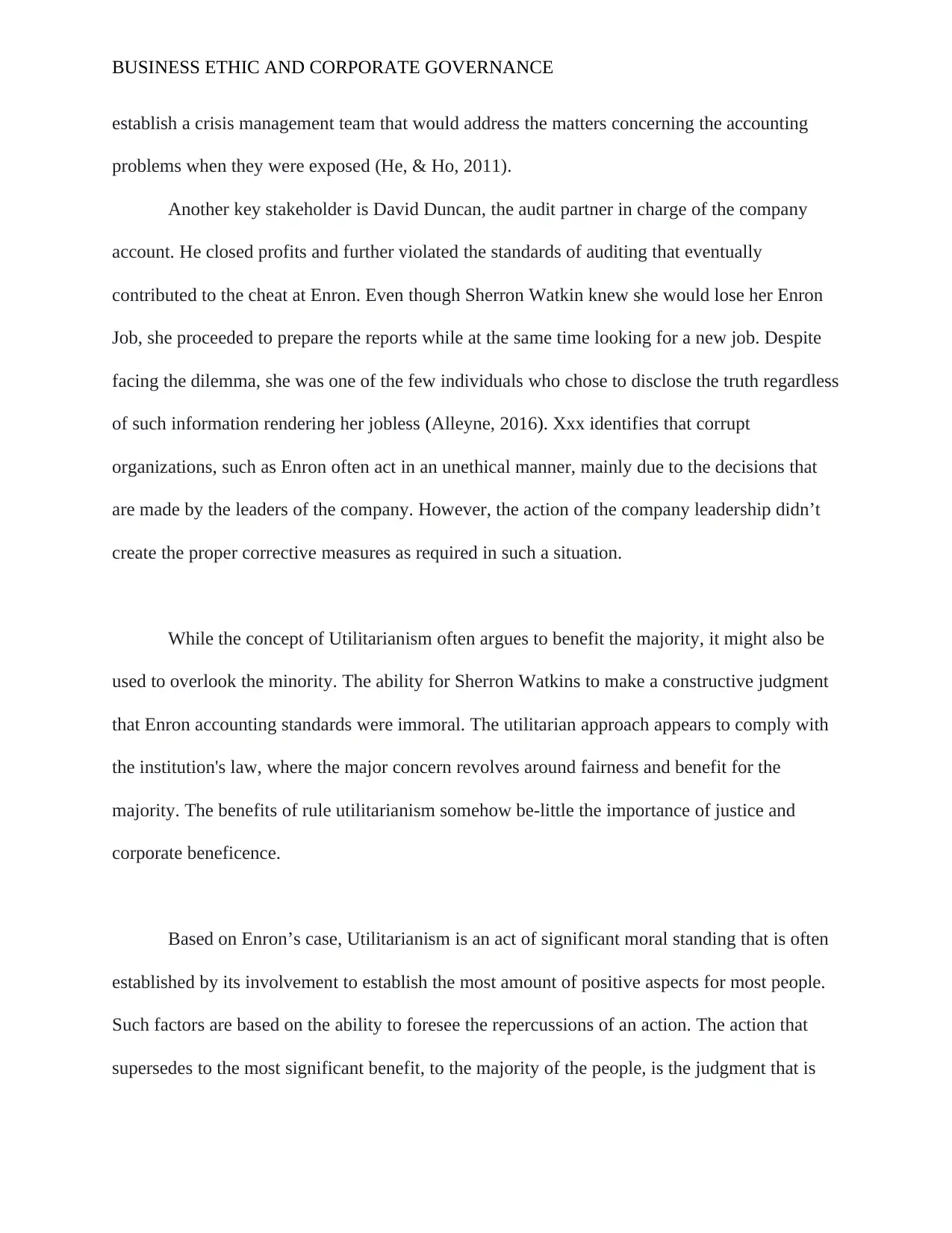
BUSINESS ETHIC AND CORPORATE GOVERNANCE
establish a crisis management team that would address the matters concerning the accounting
problems when they were exposed (He, & Ho, 2011).
Another key stakeholder is David Duncan, the audit partner in charge of the company
account. He closed profits and further violated the standards of auditing that eventually
contributed to the cheat at Enron. Even though Sherron Watkin knew she would lose her Enron
Job, she proceeded to prepare the reports while at the same time looking for a new job. Despite
facing the dilemma, she was one of the few individuals who chose to disclose the truth regardless
of such information rendering her jobless (Alleyne, 2016). Xxx identifies that corrupt
organizations, such as Enron often act in an unethical manner, mainly due to the decisions that
are made by the leaders of the company. However, the action of the company leadership didn’t
create the proper corrective measures as required in such a situation.
While the concept of Utilitarianism often argues to benefit the majority, it might also be
used to overlook the minority. The ability for Sherron Watkins to make a constructive judgment
that Enron accounting standards were immoral. The utilitarian approach appears to comply with
the institution's law, where the major concern revolves around fairness and benefit for the
majority. The benefits of rule utilitarianism somehow be-little the importance of justice and
corporate beneficence.
Based on Enron’s case, Utilitarianism is an act of significant moral standing that is often
established by its involvement to establish the most amount of positive aspects for most people.
Such factors are based on the ability to foresee the repercussions of an action. The action that
supersedes to the most significant benefit, to the majority of the people, is the judgment that is
establish a crisis management team that would address the matters concerning the accounting
problems when they were exposed (He, & Ho, 2011).
Another key stakeholder is David Duncan, the audit partner in charge of the company
account. He closed profits and further violated the standards of auditing that eventually
contributed to the cheat at Enron. Even though Sherron Watkin knew she would lose her Enron
Job, she proceeded to prepare the reports while at the same time looking for a new job. Despite
facing the dilemma, she was one of the few individuals who chose to disclose the truth regardless
of such information rendering her jobless (Alleyne, 2016). Xxx identifies that corrupt
organizations, such as Enron often act in an unethical manner, mainly due to the decisions that
are made by the leaders of the company. However, the action of the company leadership didn’t
create the proper corrective measures as required in such a situation.
While the concept of Utilitarianism often argues to benefit the majority, it might also be
used to overlook the minority. The ability for Sherron Watkins to make a constructive judgment
that Enron accounting standards were immoral. The utilitarian approach appears to comply with
the institution's law, where the major concern revolves around fairness and benefit for the
majority. The benefits of rule utilitarianism somehow be-little the importance of justice and
corporate beneficence.
Based on Enron’s case, Utilitarianism is an act of significant moral standing that is often
established by its involvement to establish the most amount of positive aspects for most people.
Such factors are based on the ability to foresee the repercussions of an action. The action that
supersedes to the most significant benefit, to the majority of the people, is the judgment that is
⊘ This is a preview!⊘
Do you want full access?
Subscribe today to unlock all pages.

Trusted by 1+ million students worldwide
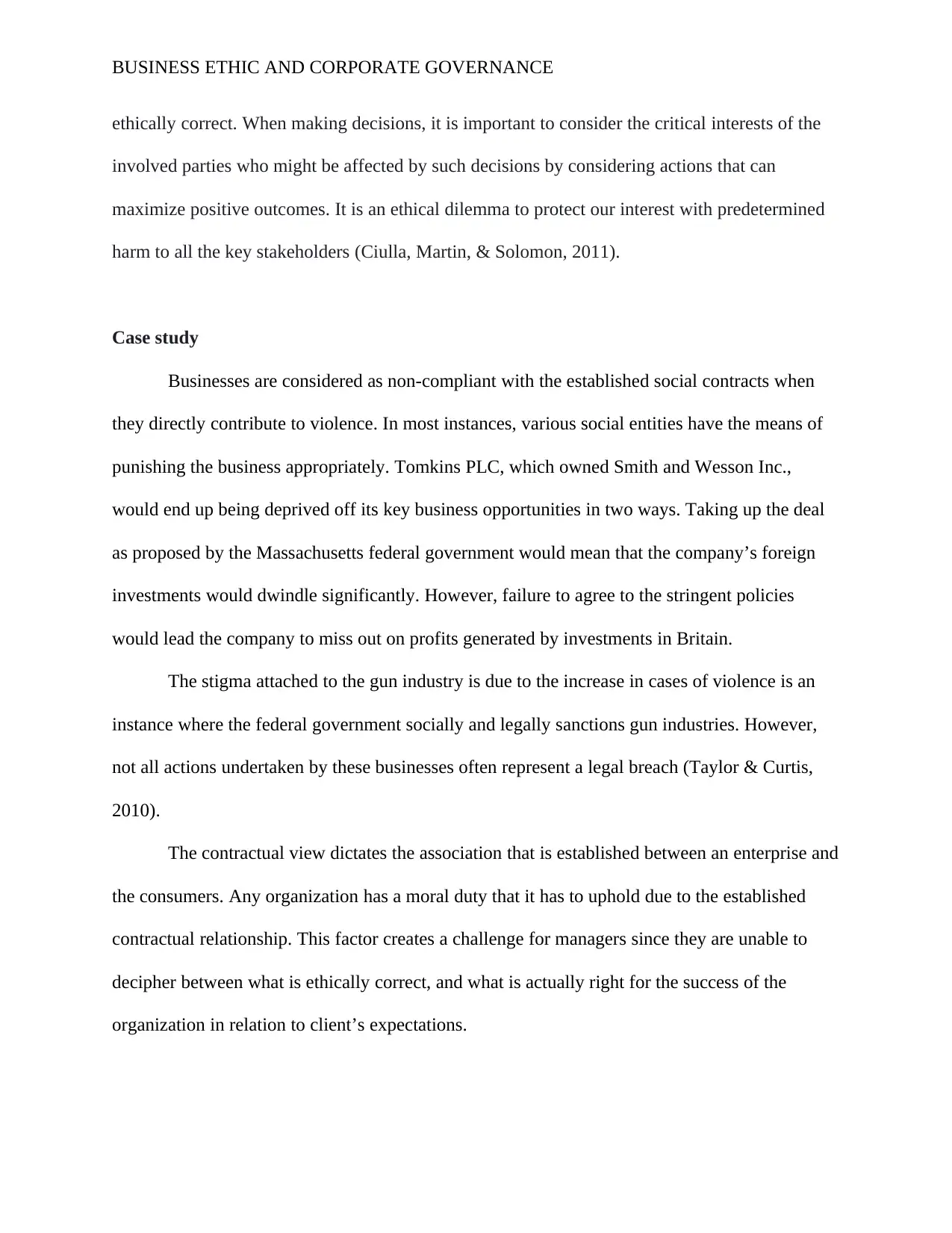
BUSINESS ETHIC AND CORPORATE GOVERNANCE
ethically correct. When making decisions, it is important to consider the critical interests of the
involved parties who might be affected by such decisions by considering actions that can
maximize positive outcomes. It is an ethical dilemma to protect our interest with predetermined
harm to all the key stakeholders (Ciulla, Martin, & Solomon, 2011).
Case study
Businesses are considered as non-compliant with the established social contracts when
they directly contribute to violence. In most instances, various social entities have the means of
punishing the business appropriately. Tomkins PLC, which owned Smith and Wesson Inc.,
would end up being deprived off its key business opportunities in two ways. Taking up the deal
as proposed by the Massachusetts federal government would mean that the company’s foreign
investments would dwindle significantly. However, failure to agree to the stringent policies
would lead the company to miss out on profits generated by investments in Britain.
The stigma attached to the gun industry is due to the increase in cases of violence is an
instance where the federal government socially and legally sanctions gun industries. However,
not all actions undertaken by these businesses often represent a legal breach (Taylor & Curtis,
2010).
The contractual view dictates the association that is established between an enterprise and
the consumers. Any organization has a moral duty that it has to uphold due to the established
contractual relationship. This factor creates a challenge for managers since they are unable to
decipher between what is ethically correct, and what is actually right for the success of the
organization in relation to client’s expectations.
ethically correct. When making decisions, it is important to consider the critical interests of the
involved parties who might be affected by such decisions by considering actions that can
maximize positive outcomes. It is an ethical dilemma to protect our interest with predetermined
harm to all the key stakeholders (Ciulla, Martin, & Solomon, 2011).
Case study
Businesses are considered as non-compliant with the established social contracts when
they directly contribute to violence. In most instances, various social entities have the means of
punishing the business appropriately. Tomkins PLC, which owned Smith and Wesson Inc.,
would end up being deprived off its key business opportunities in two ways. Taking up the deal
as proposed by the Massachusetts federal government would mean that the company’s foreign
investments would dwindle significantly. However, failure to agree to the stringent policies
would lead the company to miss out on profits generated by investments in Britain.
The stigma attached to the gun industry is due to the increase in cases of violence is an
instance where the federal government socially and legally sanctions gun industries. However,
not all actions undertaken by these businesses often represent a legal breach (Taylor & Curtis,
2010).
The contractual view dictates the association that is established between an enterprise and
the consumers. Any organization has a moral duty that it has to uphold due to the established
contractual relationship. This factor creates a challenge for managers since they are unable to
decipher between what is ethically correct, and what is actually right for the success of the
organization in relation to client’s expectations.
Paraphrase This Document
Need a fresh take? Get an instant paraphrase of this document with our AI Paraphraser
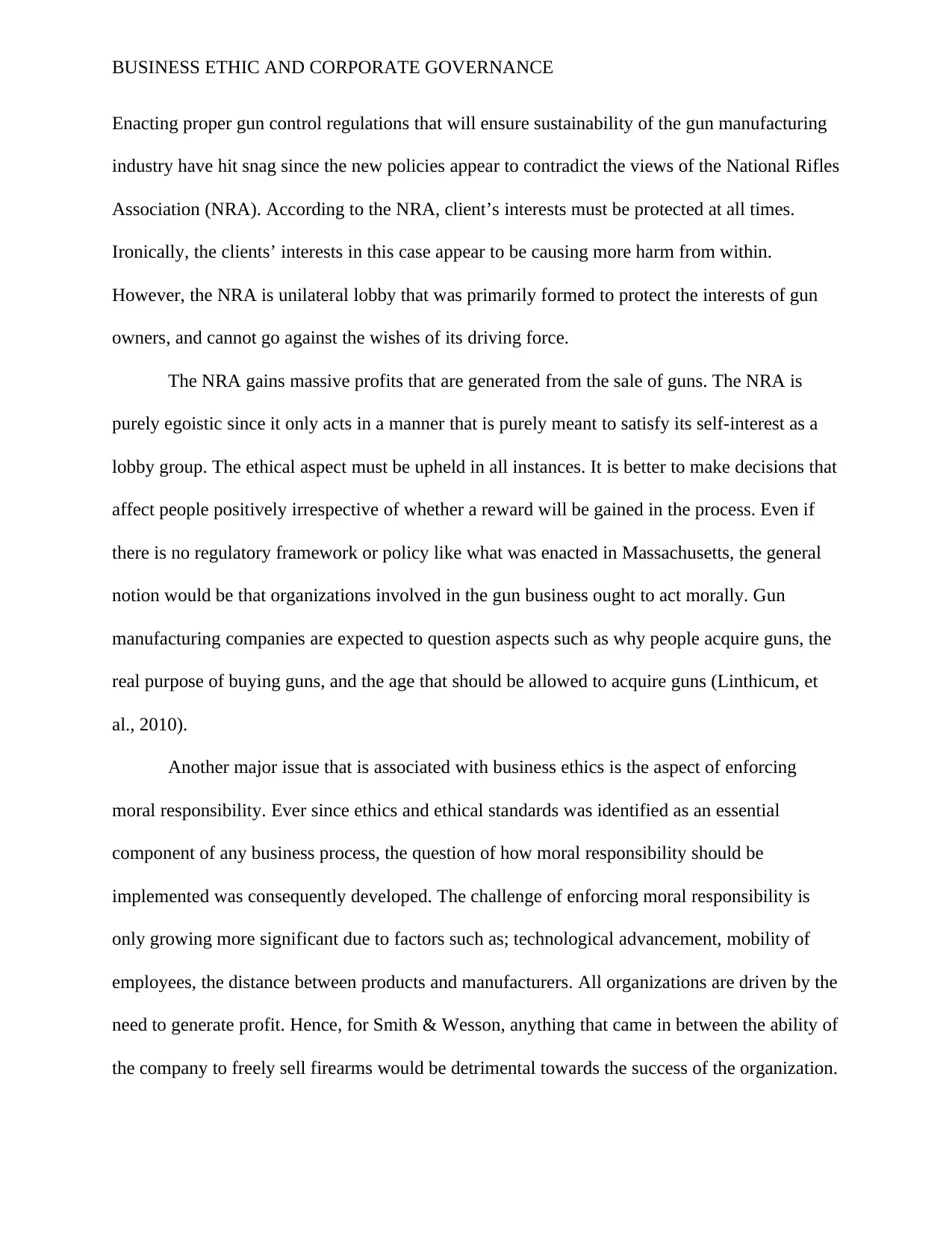
BUSINESS ETHIC AND CORPORATE GOVERNANCE
Enacting proper gun control regulations that will ensure sustainability of the gun manufacturing
industry have hit snag since the new policies appear to contradict the views of the National Rifles
Association (NRA). According to the NRA, client’s interests must be protected at all times.
Ironically, the clients’ interests in this case appear to be causing more harm from within.
However, the NRA is unilateral lobby that was primarily formed to protect the interests of gun
owners, and cannot go against the wishes of its driving force.
The NRA gains massive profits that are generated from the sale of guns. The NRA is
purely egoistic since it only acts in a manner that is purely meant to satisfy its self-interest as a
lobby group. The ethical aspect must be upheld in all instances. It is better to make decisions that
affect people positively irrespective of whether a reward will be gained in the process. Even if
there is no regulatory framework or policy like what was enacted in Massachusetts, the general
notion would be that organizations involved in the gun business ought to act morally. Gun
manufacturing companies are expected to question aspects such as why people acquire guns, the
real purpose of buying guns, and the age that should be allowed to acquire guns (Linthicum, et
al., 2010).
Another major issue that is associated with business ethics is the aspect of enforcing
moral responsibility. Ever since ethics and ethical standards was identified as an essential
component of any business process, the question of how moral responsibility should be
implemented was consequently developed. The challenge of enforcing moral responsibility is
only growing more significant due to factors such as; technological advancement, mobility of
employees, the distance between products and manufacturers. All organizations are driven by the
need to generate profit. Hence, for Smith & Wesson, anything that came in between the ability of
the company to freely sell firearms would be detrimental towards the success of the organization.
Enacting proper gun control regulations that will ensure sustainability of the gun manufacturing
industry have hit snag since the new policies appear to contradict the views of the National Rifles
Association (NRA). According to the NRA, client’s interests must be protected at all times.
Ironically, the clients’ interests in this case appear to be causing more harm from within.
However, the NRA is unilateral lobby that was primarily formed to protect the interests of gun
owners, and cannot go against the wishes of its driving force.
The NRA gains massive profits that are generated from the sale of guns. The NRA is
purely egoistic since it only acts in a manner that is purely meant to satisfy its self-interest as a
lobby group. The ethical aspect must be upheld in all instances. It is better to make decisions that
affect people positively irrespective of whether a reward will be gained in the process. Even if
there is no regulatory framework or policy like what was enacted in Massachusetts, the general
notion would be that organizations involved in the gun business ought to act morally. Gun
manufacturing companies are expected to question aspects such as why people acquire guns, the
real purpose of buying guns, and the age that should be allowed to acquire guns (Linthicum, et
al., 2010).
Another major issue that is associated with business ethics is the aspect of enforcing
moral responsibility. Ever since ethics and ethical standards was identified as an essential
component of any business process, the question of how moral responsibility should be
implemented was consequently developed. The challenge of enforcing moral responsibility is
only growing more significant due to factors such as; technological advancement, mobility of
employees, the distance between products and manufacturers. All organizations are driven by the
need to generate profit. Hence, for Smith & Wesson, anything that came in between the ability of
the company to freely sell firearms would be detrimental towards the success of the organization.
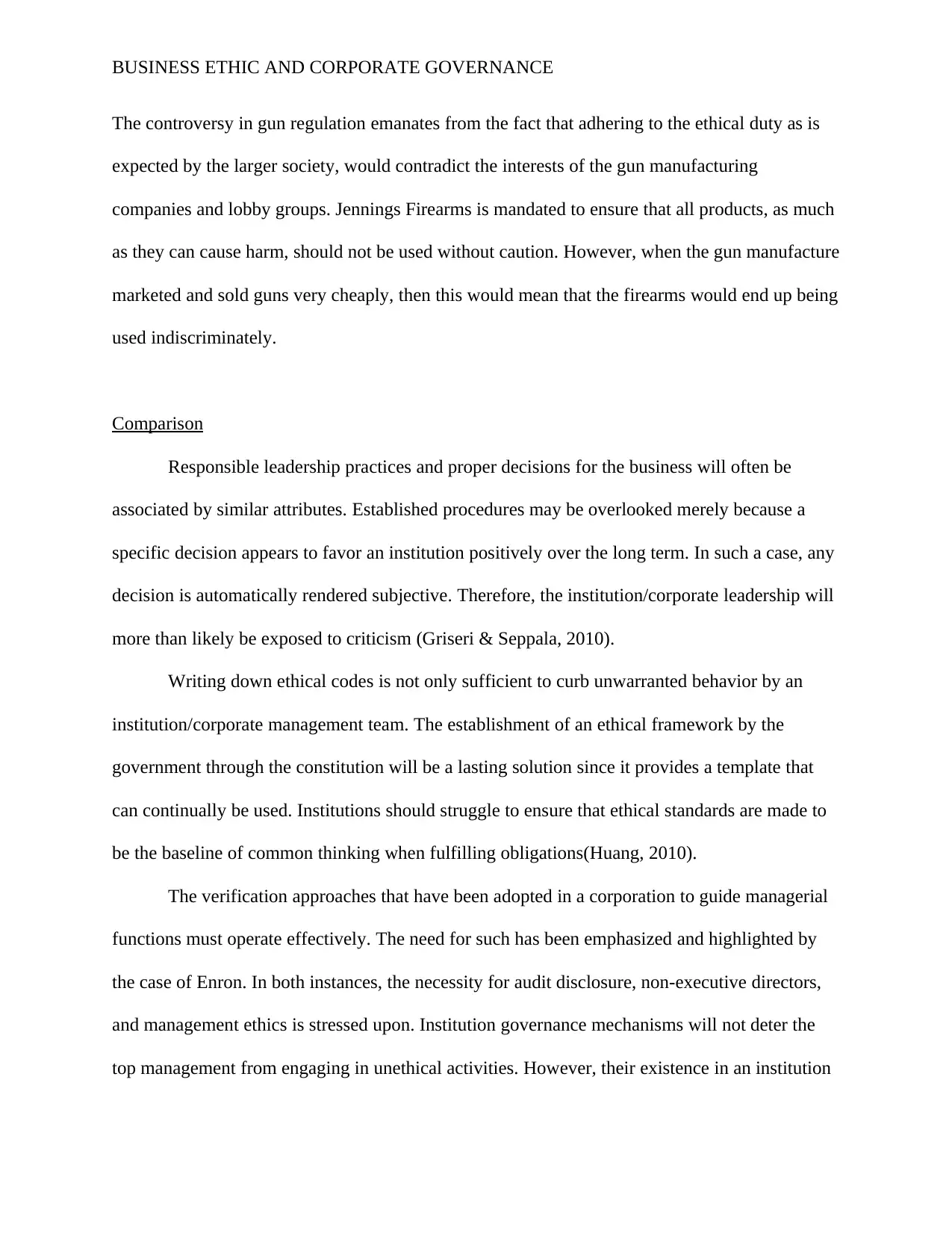
BUSINESS ETHIC AND CORPORATE GOVERNANCE
The controversy in gun regulation emanates from the fact that adhering to the ethical duty as is
expected by the larger society, would contradict the interests of the gun manufacturing
companies and lobby groups. Jennings Firearms is mandated to ensure that all products, as much
as they can cause harm, should not be used without caution. However, when the gun manufacture
marketed and sold guns very cheaply, then this would mean that the firearms would end up being
used indiscriminately.
Comparison
Responsible leadership practices and proper decisions for the business will often be
associated by similar attributes. Established procedures may be overlooked merely because a
specific decision appears to favor an institution positively over the long term. In such a case, any
decision is automatically rendered subjective. Therefore, the institution/corporate leadership will
more than likely be exposed to criticism (Griseri & Seppala, 2010).
Writing down ethical codes is not only sufficient to curb unwarranted behavior by an
institution/corporate management team. The establishment of an ethical framework by the
government through the constitution will be a lasting solution since it provides a template that
can continually be used. Institutions should struggle to ensure that ethical standards are made to
be the baseline of common thinking when fulfilling obligations(Huang, 2010).
The verification approaches that have been adopted in a corporation to guide managerial
functions must operate effectively. The need for such has been emphasized and highlighted by
the case of Enron. In both instances, the necessity for audit disclosure, non-executive directors,
and management ethics is stressed upon. Institution governance mechanisms will not deter the
top management from engaging in unethical activities. However, their existence in an institution
The controversy in gun regulation emanates from the fact that adhering to the ethical duty as is
expected by the larger society, would contradict the interests of the gun manufacturing
companies and lobby groups. Jennings Firearms is mandated to ensure that all products, as much
as they can cause harm, should not be used without caution. However, when the gun manufacture
marketed and sold guns very cheaply, then this would mean that the firearms would end up being
used indiscriminately.
Comparison
Responsible leadership practices and proper decisions for the business will often be
associated by similar attributes. Established procedures may be overlooked merely because a
specific decision appears to favor an institution positively over the long term. In such a case, any
decision is automatically rendered subjective. Therefore, the institution/corporate leadership will
more than likely be exposed to criticism (Griseri & Seppala, 2010).
Writing down ethical codes is not only sufficient to curb unwarranted behavior by an
institution/corporate management team. The establishment of an ethical framework by the
government through the constitution will be a lasting solution since it provides a template that
can continually be used. Institutions should struggle to ensure that ethical standards are made to
be the baseline of common thinking when fulfilling obligations(Huang, 2010).
The verification approaches that have been adopted in a corporation to guide managerial
functions must operate effectively. The need for such has been emphasized and highlighted by
the case of Enron. In both instances, the necessity for audit disclosure, non-executive directors,
and management ethics is stressed upon. Institution governance mechanisms will not deter the
top management from engaging in unethical activities. However, their existence in an institution
⊘ This is a preview!⊘
Do you want full access?
Subscribe today to unlock all pages.

Trusted by 1+ million students worldwide
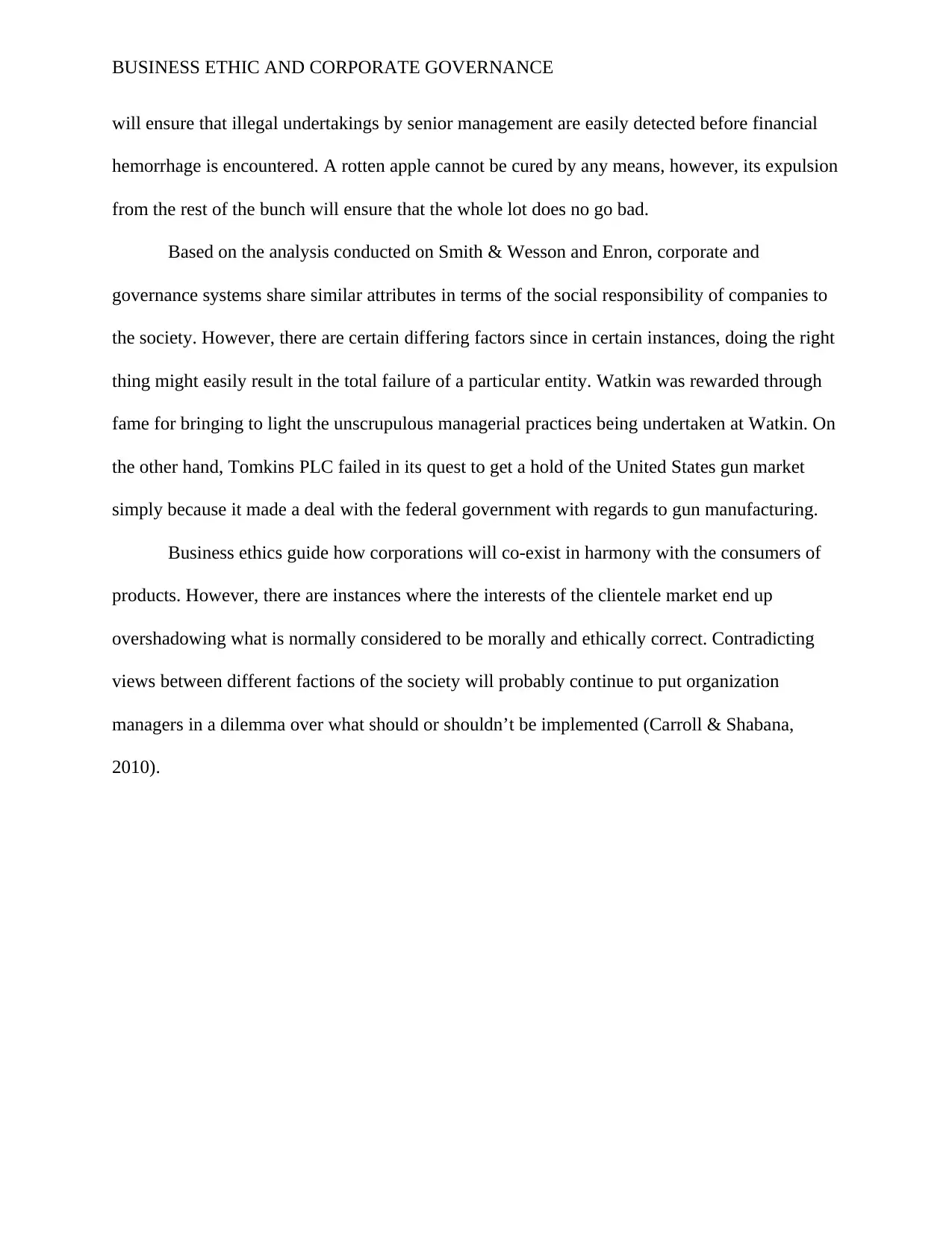
BUSINESS ETHIC AND CORPORATE GOVERNANCE
will ensure that illegal undertakings by senior management are easily detected before financial
hemorrhage is encountered. A rotten apple cannot be cured by any means, however, its expulsion
from the rest of the bunch will ensure that the whole lot does no go bad.
Based on the analysis conducted on Smith & Wesson and Enron, corporate and
governance systems share similar attributes in terms of the social responsibility of companies to
the society. However, there are certain differing factors since in certain instances, doing the right
thing might easily result in the total failure of a particular entity. Watkin was rewarded through
fame for bringing to light the unscrupulous managerial practices being undertaken at Watkin. On
the other hand, Tomkins PLC failed in its quest to get a hold of the United States gun market
simply because it made a deal with the federal government with regards to gun manufacturing.
Business ethics guide how corporations will co-exist in harmony with the consumers of
products. However, there are instances where the interests of the clientele market end up
overshadowing what is normally considered to be morally and ethically correct. Contradicting
views between different factions of the society will probably continue to put organization
managers in a dilemma over what should or shouldn’t be implemented (Carroll & Shabana,
2010).
will ensure that illegal undertakings by senior management are easily detected before financial
hemorrhage is encountered. A rotten apple cannot be cured by any means, however, its expulsion
from the rest of the bunch will ensure that the whole lot does no go bad.
Based on the analysis conducted on Smith & Wesson and Enron, corporate and
governance systems share similar attributes in terms of the social responsibility of companies to
the society. However, there are certain differing factors since in certain instances, doing the right
thing might easily result in the total failure of a particular entity. Watkin was rewarded through
fame for bringing to light the unscrupulous managerial practices being undertaken at Watkin. On
the other hand, Tomkins PLC failed in its quest to get a hold of the United States gun market
simply because it made a deal with the federal government with regards to gun manufacturing.
Business ethics guide how corporations will co-exist in harmony with the consumers of
products. However, there are instances where the interests of the clientele market end up
overshadowing what is normally considered to be morally and ethically correct. Contradicting
views between different factions of the society will probably continue to put organization
managers in a dilemma over what should or shouldn’t be implemented (Carroll & Shabana,
2010).
Paraphrase This Document
Need a fresh take? Get an instant paraphrase of this document with our AI Paraphraser
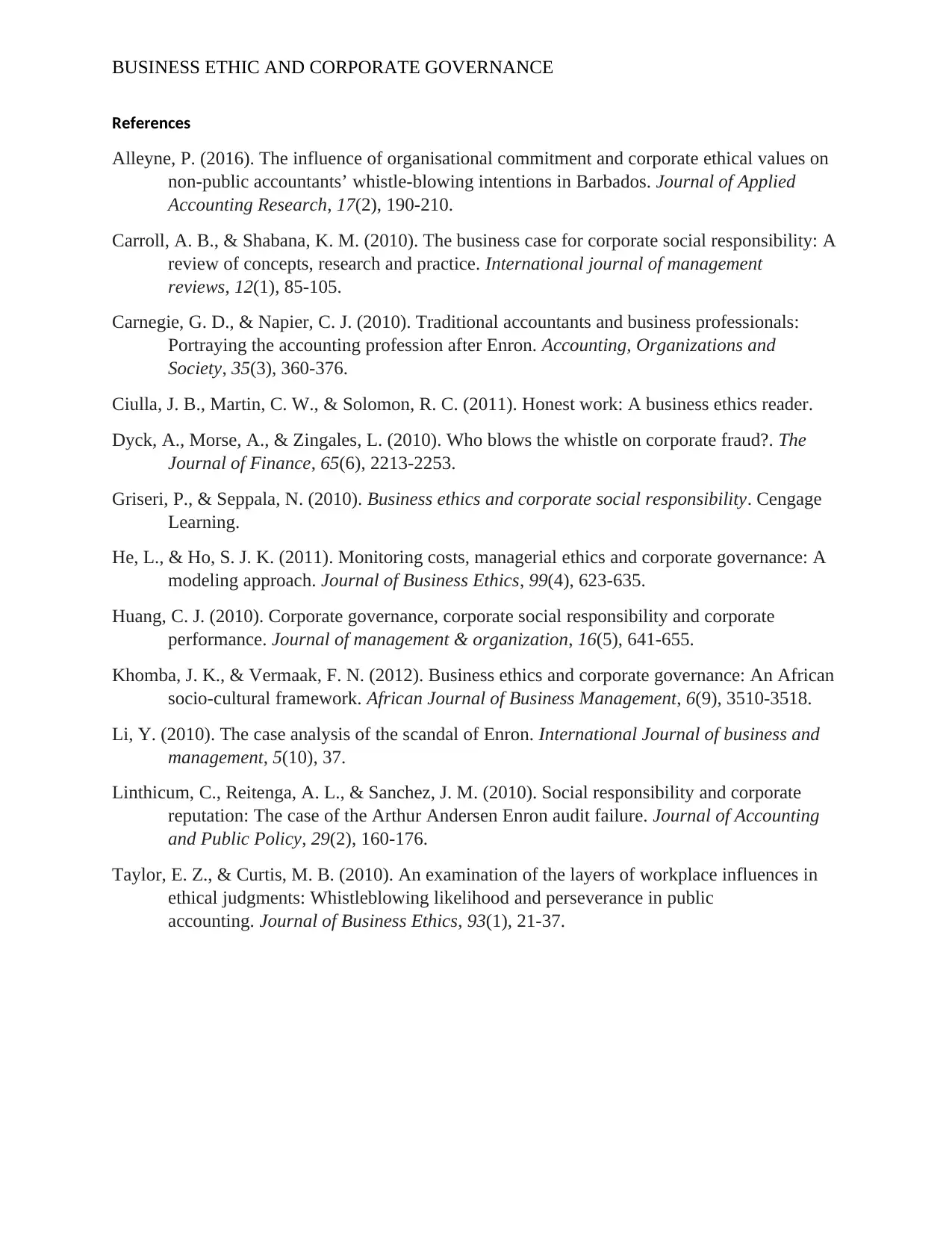
BUSINESS ETHIC AND CORPORATE GOVERNANCE
References
Alleyne, P. (2016). The influence of organisational commitment and corporate ethical values on
non-public accountants’ whistle-blowing intentions in Barbados. Journal of Applied
Accounting Research, 17(2), 190-210.
Carroll, A. B., & Shabana, K. M. (2010). The business case for corporate social responsibility: A
review of concepts, research and practice. International journal of management
reviews, 12(1), 85-105.
Carnegie, G. D., & Napier, C. J. (2010). Traditional accountants and business professionals:
Portraying the accounting profession after Enron. Accounting, Organizations and
Society, 35(3), 360-376.
Ciulla, J. B., Martin, C. W., & Solomon, R. C. (2011). Honest work: A business ethics reader.
Dyck, A., Morse, A., & Zingales, L. (2010). Who blows the whistle on corporate fraud?. The
Journal of Finance, 65(6), 2213-2253.
Griseri, P., & Seppala, N. (2010). Business ethics and corporate social responsibility. Cengage
Learning.
He, L., & Ho, S. J. K. (2011). Monitoring costs, managerial ethics and corporate governance: A
modeling approach. Journal of Business Ethics, 99(4), 623-635.
Huang, C. J. (2010). Corporate governance, corporate social responsibility and corporate
performance. Journal of management & organization, 16(5), 641-655.
Khomba, J. K., & Vermaak, F. N. (2012). Business ethics and corporate governance: An African
socio-cultural framework. African Journal of Business Management, 6(9), 3510-3518.
Li, Y. (2010). The case analysis of the scandal of Enron. International Journal of business and
management, 5(10), 37.
Linthicum, C., Reitenga, A. L., & Sanchez, J. M. (2010). Social responsibility and corporate
reputation: The case of the Arthur Andersen Enron audit failure. Journal of Accounting
and Public Policy, 29(2), 160-176.
Taylor, E. Z., & Curtis, M. B. (2010). An examination of the layers of workplace influences in
ethical judgments: Whistleblowing likelihood and perseverance in public
accounting. Journal of Business Ethics, 93(1), 21-37.
References
Alleyne, P. (2016). The influence of organisational commitment and corporate ethical values on
non-public accountants’ whistle-blowing intentions in Barbados. Journal of Applied
Accounting Research, 17(2), 190-210.
Carroll, A. B., & Shabana, K. M. (2010). The business case for corporate social responsibility: A
review of concepts, research and practice. International journal of management
reviews, 12(1), 85-105.
Carnegie, G. D., & Napier, C. J. (2010). Traditional accountants and business professionals:
Portraying the accounting profession after Enron. Accounting, Organizations and
Society, 35(3), 360-376.
Ciulla, J. B., Martin, C. W., & Solomon, R. C. (2011). Honest work: A business ethics reader.
Dyck, A., Morse, A., & Zingales, L. (2010). Who blows the whistle on corporate fraud?. The
Journal of Finance, 65(6), 2213-2253.
Griseri, P., & Seppala, N. (2010). Business ethics and corporate social responsibility. Cengage
Learning.
He, L., & Ho, S. J. K. (2011). Monitoring costs, managerial ethics and corporate governance: A
modeling approach. Journal of Business Ethics, 99(4), 623-635.
Huang, C. J. (2010). Corporate governance, corporate social responsibility and corporate
performance. Journal of management & organization, 16(5), 641-655.
Khomba, J. K., & Vermaak, F. N. (2012). Business ethics and corporate governance: An African
socio-cultural framework. African Journal of Business Management, 6(9), 3510-3518.
Li, Y. (2010). The case analysis of the scandal of Enron. International Journal of business and
management, 5(10), 37.
Linthicum, C., Reitenga, A. L., & Sanchez, J. M. (2010). Social responsibility and corporate
reputation: The case of the Arthur Andersen Enron audit failure. Journal of Accounting
and Public Policy, 29(2), 160-176.
Taylor, E. Z., & Curtis, M. B. (2010). An examination of the layers of workplace influences in
ethical judgments: Whistleblowing likelihood and perseverance in public
accounting. Journal of Business Ethics, 93(1), 21-37.
1 out of 8
Related Documents
Your All-in-One AI-Powered Toolkit for Academic Success.
+13062052269
info@desklib.com
Available 24*7 on WhatsApp / Email
![[object Object]](/_next/static/media/star-bottom.7253800d.svg)
Unlock your academic potential
Copyright © 2020–2025 A2Z Services. All Rights Reserved. Developed and managed by ZUCOL.





